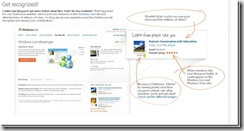Consider these community facts (these are real, hard metrics from a number of brand communities but are sanitized and general for reasons of NDA). Keep in mind, the metrics I am sharing are only the tip of the iceberg of what can and should be measured to effectively determine a community’s performance.
- A group of several hundred (less than 500) advocates in one community generate over 500,000 page views with the UGC they create. That UGC they create offsets the need for branded content and is more effective. Marketing pages that receive this content outperform their traditional counterparts in terms of dwell time by over 50%.
- This content has significantly increased both product use/downloads and ad impressions as measured against more traditional methods.
- This UGC is syndicated into outbound CRM messaging. Advocate content increases the click through rate by over 40%.
- A group of only 10 advocates within a community, focused on product support, is responsible for delivering $1,000,000 in support savings (as measured by cost deflection) to the brand on an annual basis.
Using a tool ComBlu invented and has spent the last year refining called the Community Performance Index ™, we can generate a set of performance metrics that helps the marketing and community management team to intimately understand what’s going on in their community, as well as, what is driving that activity. It gives them the ability to deliver to management quantitative metrics as to the value of the community to the brand.
Think of it like a Community Net Promoter Score, only better…ok, maybe just more evolved than NPS since you can’t triangulate a position (i.e. measure where you are) with one datapoint (try doing it on a map and you’ll see what I mean). But this is another blog post. Back to topic…
Also, I mention both ‘Advocates’ and ‘Members’ when talking about community. Advocates are the heartbeat of any vibrant community and contrary to some positions, advocates are critical to a community’s success. Advocates have a different role in community than general members. Why? They are ‘wired’ differently than the everyday person. They are more influential because of what they know and their place in the social graph. Tapping and engaging advocates early and asking them to play a role in the development and growth of a community is critical.
It’s important to note I am not talking about Influencers. Here’s how we (ComBlu) make the distinction. Influencers are people with big megaphones and reach a very large audience. Charlene Li is a great example of an Influencer.

Advocates are everyday people equipped with microphones. They broadcast to their social networks and peers. ‘Andy B.’ is great example of an Advocate.

From the user’s side (either an Advocate or an everyday Community Member), the index allows the community to evolve efficiently, so that it provides a high level of utility to as many members of the community as is possible. Using the index, it is easy to change what doesn’t work and enhance what does. From the user’s perspective, the net result is a very positive and sticky experience. The user wants to come back. They want to use more of the products and services the brand offers. They want to advocate about their experience. They have greater affinity for the brand. They have fun and enjoy the experience. The community shifts from a ‘want’ to a ‘need’.
This activity isn’t limited to just the four walls of the community either. The content that the community members generate is aggregated and then syndicated out across the Internet, impacting the awareness of millions, even tens of millions who encounter this content; all of which is in the voice of the customer, is first hand and genuine. Using the Performance Index, even sentiment, reach and impact can be measured.
Granted, all of the content isn’t perfectly flattering. However, if it is a well performing community, change is a constant and dialogue is two way. Brand bombs (negative content) is a rarity that more often than not is effectively managed by community members themselves, not the brand. Good brands don’t hinder negative content, they learn from it and act on it. Community members help each other have a more enjoyable experience with something they have a shared interest in. A brand’s job is to listen and learn first. Then act.
That is why measuring performance is so key, so you know how and where to act. Guessing is largely removed from the equation.
In part three of this blog post, I’ll reveal how Community Performance Indexing works.

